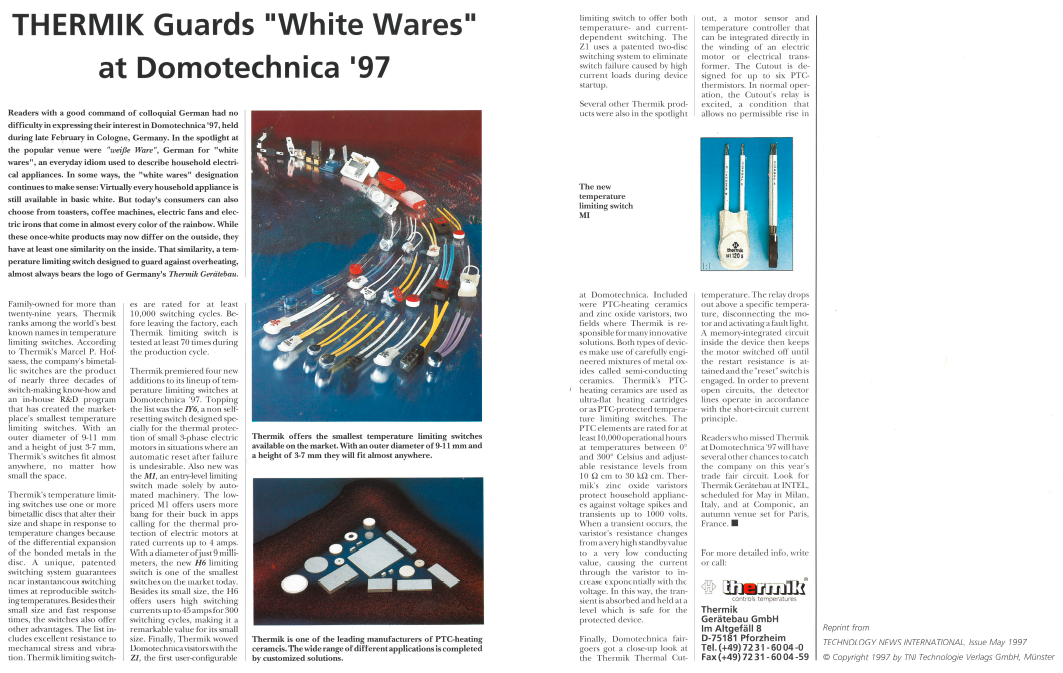Thermik guards „White Wares“ at Domotechnica 1997
Family-owned for more than twenty-nine years, Thermik ranks among the worlds best know names in temperature limiting switches.

Family-owned for more than twenty-nine years, Thermik ranks among the worlds best know names in temperature limiting switches.

Readers with a good command of colloquial German had no difficulty in expressing their interest in Domotechnica '97, held during late February in Cologne, Germany. In the spotlight at the popular venue were „weiße Ware“, German for „white wares“, an everyday idiom used to describe household electrical appliances. In some ways, the „white wares“ designation continues to make sense: Virtually every household appliance is still available in basic white. But today's consumers can also choose from toasters, coffee machines, electric fans and electric irons that come in almost every color of the rainbow. While these once-white products may now differ on the outside, they have at least one similarity on the inside. That similarity, a temperature limiting switch designed to guard against overheating, almost always bears the logo of Germany's Thermik Gerätebau.
Family-owned for more than twenty-nine years, Thermik ranks among the world's best known names in temperature limiting switches. According to Thermik's Marcel P. Hofsaess, the company's bimetallic switches are the product of nearly three decades of switch-making know-how and an in-house R&D program that has created the marketplace's smallest temperature limiting switches. With an outer diameter of 9-11 mm and a height of just 3-7 mm, Thermik's switches fit almost anywhere, no matter how small the space.
Thermik's temperature limiting switches use one or more bimetallic discs that alter their size and shape in response to temperature changes because of the differential expansion of the bonded metals in the disc. A unique, patented switching system guarantees near instantaneous switching times at reproducible switching temperatures. Besides their small size and fast response times, the switches also offer other advantages. The list includes excellent resistance to mechanical stress and vibration. Thermik limiting switches are rated for at least 10,000 switching cycles. Before leaving the factory, each Thermik limiting switch is tested at least 70 times during the production cycle.
Thermik premiered four new additions to its lineup of temperature limiting switches at Domotechnica '97. Topping the list was the IY6, a non self-resetting switch designed specially for the thermal protection of small 3-phase electric motors in situations where an automatic reset after failure is undesirable. Also new was the M1, an entry-level limiting switch made solely by automated machinery. The low-priced M1 offers users more bang for their buck in apps calling for the thermal protection of electric motors at rated currents up to 4 amps. With a diameter of just 9 millimeters, the new H6 limiting switch is one of the smallest switches on the market today. Besides its small size, the H6 offers users high switching currents up to 45 amps for 300 switching cycles, making it a remarkable value for its small size. Finally, Thermik wowed Domotechnica visitors with the Z1, the first user-configurable limiting switch to offer both temperature- and current-dependent switching. The Z1 uses a patented two-disc switch failure caused by high current loads during device startup.
Several other Thermik products were also in the spotlight at Domotechnica. Included were PTC-heating ceramics and zinc oxide varistors, two fields where Thermik is responsible for many innovative solutions. Both types of devices make use of carefully engineered mixtures of metal oxides called semi-conducting ceramics. Thermik's PTC-heating ceramics are used as ultra-flat heating cartridges or as PTC-protected temperature limiting switch. The PTC elements are rated for at least 10,000 operational hours at temperatures between 0° and 300° Celsius and adjustable resistance levels from 10 Ω cm to 30 kΩ cm. Thermik's zinc oxide varistors protect household appliances against voltage spikes and transients up to 1000 volts. When a transient occurs, the varistor's resistance changes from a very high standby value to a very low conducting value, causing the current through the varistor to increase exponentially with the voltage. In this way, the transient is absorbed and held at a level which is safe for the protected device.
Finally, Domotechnica fairgoers got a close-up look at the Thermik Thermal Cutout, a motor sensor and temperature controller that can be integrated directly in the winding of an electric motor or electrical transformer. The Cutout is designed for up to six PTC-thermistors. In normal operation, the Cutout's relay is excited, a condition that allows no permissible rise in temperature. The relay drops out above a specific temperature, disconnecting the motor and activating a fault light. A memory-integrated circuit inside the device then keeps the motor switched off until the restart resistance is attained and the "reset" switch is engaged. In order to prevent open circuits, the detector lines operate in accordance with the short-circuit current principle.
Readers who missed Thermik at Domotechnica '97 will have several other chances to catch the company on this year's trade fair circuit. Look for Thermik Gerätebau at INTEL, scheduled for May in Milan, Italy, and at Componic, an autumn venue set for Paris, France.